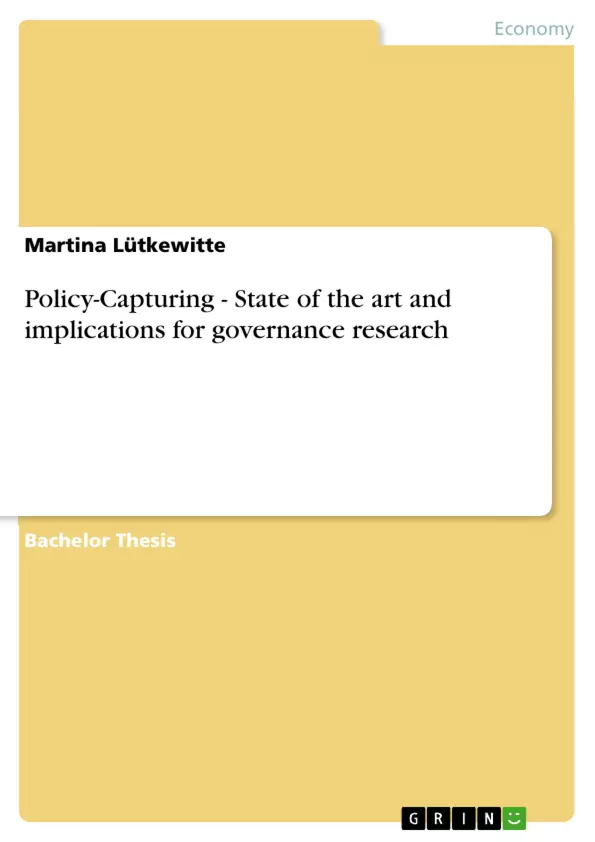In the following, I will give a short outline of the content of the thesis at hand.
As my topic deals with the application of Policy-Capturing (PC) studies in governance
research, I will first address both terms – the PC technique and a definition of governance decisions – separately and then combine the explanations into a superordinate context.
Chapter 5 attends to the typical steps a PC study consists of and describes representative questions and decisions researchers have to consider at every stage of their research, namely study design, study execution,
analysis, interpreting results and reporting results.
Subsequently, I will describe my process of finding suitable articles and give a brief survey of the PC studies dealing with governance decisions as well as those from other areas of research which I reviewed and analyzed.
The following section covers obstacles that researchers conducting a PC study may frequently be confronted with, offers solutions on how to overcome those hurdles in case of occurrence and provides the reader with guidelines that should be adhered to in order to enhance the study’s design and execution as well as the results’ analysis, interpretation and reporting.
Having covered PC in extenso, the next chapter discusses conjoint analysis as a closely related technique highlighting conspicuous parallels to PC and giving some advice scholars employing PC could also
benefit from.
I end my thesis with a conclusion, summing up the most important and most interesting findings and giving a brief outlook on the future of the application of PC studies in governance research.
Table of Contents
- 1 PREFACE
- 2 ABSTRACT
- 3 POLICY-CAPTURING STUDIES
- 3.1 INTRODUCTION
- 3.2 REASONS FOR POLICY-CAPTURING
- 3.3 APPLICATIONS OF POLICY-CAPTURING
- 3.4 POLICY-CAPTURING IN GOVERNANCE RESEARCH
- 4 CORPORATE GOVERNANCE AND GOVERNANCE DECISIONS
- 5 STEPS OF POLICY-CAPTURING
- 5.1 STEP 1: STUDY DESIGN
- 5.2 STEP 2: STUDY EXECUTION
- 5.3 STEP 3: ANALYSIS
- 5.4 STEP 4: INTERPRETING RESULTS
- 5.5 STEP 5: REPORTING RESULTS
- 6 ARTICLES
- 6.1 FINDING ARTICLES / DATA COLLECTION
- 6.2 ARTICLES FROM GOVERNANCE RESEARCH
- 6.2.1 Reasons for PC
- 6.2.2 Noteworthy Characteristics
- 6.3 ARTICLES FROM OTHER AREAS OF RESEARCH
- 6.3.1 Reasons for PC
- 6.3.2 Noteworthy Characteristics
- 7 OBSTACLES AND GUIDELINES
- 7.1 STEP 1: STUDY DESIGN
- 7.2 STEP 2: STUDY EXECUTION
- 7.3 STEP 3: ANALYSIS
- 7.4 STEP 4: INTERPRETING RESULTS
- 7.5 STEP 5: REPORTING RESULTS
- 8 CONJOINT ANALYSIS
- 8.1 STEPS OF CONJOINT ANALYSIS
- 8.2 QUESTIONS IN CONJOINT ANALYSIS
- 9 CONCLUSION
Objectives and Key Themes
This thesis provides a comprehensive overview of the policy-capturing method in governance research. It aims to analyze its application, explore its strengths and limitations, and offer practical guidelines for researchers. The main objectives are:- To introduce the policy-capturing method and its application in governance research.
- To review existing literature on policy-capturing studies in various fields, focusing on the reasons for its use and its noteworthy characteristics.
- To identify common obstacles and provide guidelines for researchers using policy-capturing in their studies.
- To discuss the relationship between policy-capturing and corporate governance decisions.
- To examine the potential of conjoint analysis within the framework of policy-capturing.
Chapter Summaries
- Chapter 3 provides an introduction to the policy-capturing method, outlining its core principles and applications. It explores the rationale behind its use, its relevance to governance research, and its potential for understanding corporate governance decisions.
- Chapter 4 examines the intersection of policy-capturing and corporate governance. It delves into how this method can be used to understand the decision-making processes within organizations and shed light on the influence of various factors on corporate governance practices.
- Chapter 5 breaks down the five key steps involved in conducting a policy-capturing study, providing a structured framework for researchers. Each step is explored in detail, highlighting practical considerations and potential challenges.
- Chapter 6 presents a comprehensive review of existing articles employing policy-capturing in governance research and other fields. The chapter analyzes the reasons for its use, its unique characteristics, and its impact on different areas of research.
- Chapter 7 focuses on overcoming obstacles and providing practical guidelines for researchers using policy-capturing. It offers solutions to common challenges, addresses potential pitfalls, and emphasizes best practices to ensure rigorous and reliable results.
- Chapter 8 delves into the potential of conjoint analysis within the context of policy-capturing. It explores the integration of this technique, its advantages, and its potential for enhancing the power and scope of policy-capturing studies.
Keywords
This thesis focuses on the application of policy-capturing in governance research. Key concepts include corporate governance, decision-making, research methodology, conjoint analysis, and the analysis of policy preferences. This work explores the practical application of this method, examines its strengths and limitations, and provides guidance for its implementation.- Quote paper
- Martina Lütkewitte (Author), 2006, Policy-Capturing - State of the art and implications for governance research, Munich, GRIN Verlag, https://www.grin.com/document/86282



